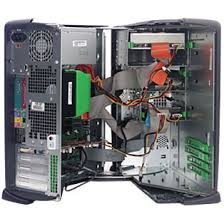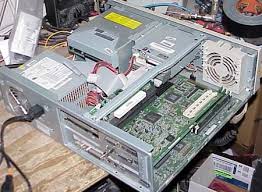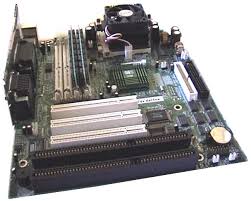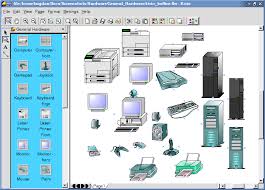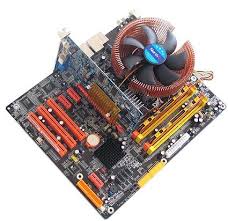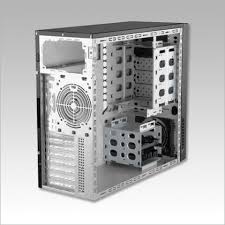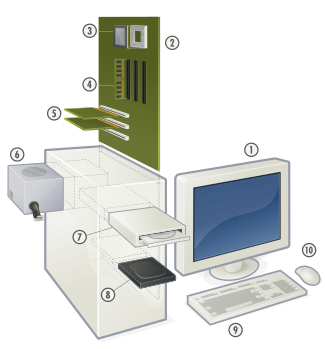- This article is about graphics created using computers. For the article about the scientific study of computer graphics, see Computer graphics (computer science). For other uses, see Computer graphics (disambiguation).
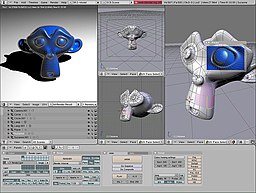
A Blender 2.45 screenshot.
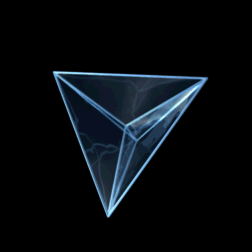
A 2D projection of a 3D projection of a 4D Pentachoron performing a double rotation about two
orthogonal planes.
Computer graphics are graphics created using computers and, more generally, the representation and manipulation of image data by a computer.
The development of computer graphics, or simply referred to as CG, has made computers easier to interact with, and better for understanding and interpreting many types of data. Developments in computer graphics have had a profound impact on many types of media and have revolutionized the animation and video game industry.
| Contents [hide] - 1 Overview
- 2 History
- 3 Image types
- 3.1 2D computer graphics
- 3.1.1 Pixel art
- 3.1.2 Vector graphics
- 3.2 3D computer graphics
- 3.3 Computer animation
- 4 Concepts and Principles
- 4.1 Image
- 4.2 Pixel
- 4.3 Graphics
- 4.4 Rendering
- 4.5 Volume rendering
- 4.6 3D modeling
- 5 Pioneers in graphic design
- 6 The study of computer graphics
- 7 Applications
- 8 References
- 9 Further reading
- 10 External links
|
[edit] Overview
The term computer graphics has been used in a broad sense to describe "almost everything on computers that is not text or sound"[1]. Typically, the term computer graphics refers to several different things:
- the representation and manipulation of image data by a computer
- the various technologies used to create and manipulate images
- the images so produced, and
- the sub-field of computer science which studies methods for digitally synthesizing and manipulating visual content, see study of computer graphics
Today, computers and computer-generated images touch many aspects of our daily life. Computer imagery is found on television, in newspapers, for example in their weather reports, or for example in all kinds of medical investigation and surgical procedures. A well-constructed graph can present complex statistics in a form that is easier to understand and interpret. In the media "such graphs are used to illustrate papers, reports, theses", and other presentation material.[2]
Many powerful tools have been developed to visualize data. Computer generated imagery can be categorized into several different types: 2D, 3D, and animated graphics. As technology has improved, 3D computer graphics have become more common, but 2D computer graphics are still widely used. Computer graphics has emerged as a sub-field of computer science which studies methods for digitally synthesizing and manipulating visual content. Over the past decade, other specialized fields have been developed like information visualization, and scientific visualization more concerned with "the visualization of three dimensional phenomena (architectural, meteorological, medical, biological, etc.), where the emphasis is on realistic renderings of volumes, surfaces, illumination sources, and so forth, perhaps with a dynamic (time) component".[3]
[edit] History
The phrase “Computer Graphics” was coined in 1960 by William Fetter, a graphic designer for Boeing.[4] The field of computer graphics developed with the emergence of computer graphics hardware. Early projects like the Whirlwind and SAGE Projects introduced the CRT as a viable display and interaction interface and introduced the light pen as an input device.

SAGE Sector Control Room.
Further advances in computing led to greater advancements in interactive computer graphics. In 1959, the TX-2 computer was developed at MIT's Lincoln Laboratory. The TX-2 integrated a number of new man-machine interfaces. A light pen could be used to draw sketches on the computer using Ivan Sutherland's revolutionary Sketchpad software. The development of Sketchpad made Ivan Sutherland the "grandfather" of interactive computer graphics and graphical user interfaces.[4]
The research at MIT "would help shape the early computer and computer graphics industries"[5]. Major corporations soon became interested in the technology. IBM quickly responded "by releasing the IBM 2250 graphics terminal, the first commercially available graphics computer".[5] Several computer graphics companies were founded in the mid 1960s including TRW, Lockheed-Georgia, General Electric and Sperry Rand.
In 1969, the ACM initiated A Special Interest Group in Graphics (SIGGRAPH) which organizes conferences, graphics standards, and publications within the field of computer graphics. In 1973, the first annual SIGGRAPH conference was held, which has become one of the focuses of the organization. SIGGRAPH has grown in size and importance as the field of computer graphics has expanded over time. Many of the most important early breakthroughs in computer graphics research occurred at the University of Utah in the 1970s.
In the 1980s, artists and graphic designers began to see the personal computer, particularly the Commodore Amiga and Macintosh, as a serious design tool, one that could save time and draw more accurately than other methods. In the late 1980s, SGI computers were used to create some of the first fully computer-generated short films at Pixar. The Macintosh remains a highly popular tool for computer graphics among graphic design studios and businesses. Modern computers, dating from the 1980s often use graphical user interfaces (GUI) to present data and information with symbols, icons and pictures, rather than text. Graphics are one of the five key elements of multimedia technology.
3D graphics became more popular in the 1990s in gaming, multimedia and animation. In 1996, Quake, one of the first fully 3D games, was released. In 1995, Toy Story, the first full-length computer-generated animation film, was released in cinemas worldwide. Since then, computer graphics have only become more detailed and realistic, due to more powerful graphics hardware and 3D modeling software.
[edit] Image types
[edit] 2D computer graphics

Raster graphic sprites (left) and masks (right)
2D computer graphics are the computer-based generation of digital images—mostly from two-dimensional models, such as 2D geometric models, text, and digital images, and by techniques specific to them. The word may stand for the branch of computer science that comprises such techniques, or for the models themselves.
2D computer graphics are mainly used in applications that were originally developed upon traditional printing and drawing technologies, such as typography, cartography, technical drawing, advertising, etc.. In those applications, the two-dimensional image is not just a representation of a real-world object, but an independent artifact with added semantic value; two-dimensional models are therefore preferred, because they give more direct control of the image than 3D computer graphics, whose approach is more akin to photography than to typography.
[edit] Pixel art
Pixel art is a form of digital art, created through the use of raster graphics software, where images are edited on the pixel level. Graphics in most old (or relatively limited) computer and video games, graphing calculator games, and many mobile phone games are mostly pixel art.
[edit] Vector graphics

Example showing effect of vector graphics versus raster (bitmap) graphics.
Vector graphics formats are complementary to raster graphics, which is the representation of images as an array of pixels, as it is typically used for the representation of photographic images.[6] There are instances when working with vector tools and formats is best practice, and instances when working with raster tools and formats is best practice. There are times when both formats come together. An understanding of the advantages and limitations of each technology and the relationship between them is most likely to result in efficient and effective use of tools.
[edit] 3D computer graphics
3D computer graphics in contrast to 2D computer graphics are graphics that use a three-dimensional representation of geometric data that is stored in the computer for the purposes of performing calculations and rendering 2D images. Such images may be for later display or for real-time viewing.
Despite these differences, 3D computer graphics rely on many of the same algorithms as 2D computer vector graphics in the wire frame model and 2D computer raster graphics in the final rendered display. In computer graphics software, the distinction between 2D and 3D is occasionally blurred; 2D applications may use 3D techniques to achieve effects such as lighting, and primarily 3D may use 2D rendering techniques.
3D computer graphics are often referred to as 3D models. Apart from the rendered graphic, the model is contained within the graphical data file. However, there are differences. A 3D model is the mathematical representation of any three-dimensional object (either inanimate or living). A model is not technically a graphic until it is visually displayed. Due to 3D printing, 3D models are not confined to virtual space. A model can be displayed visually as a two-dimensional image through a process called 3D rendering, or used in non-graphical computer simulations and calculations.
[edit] Computer animation
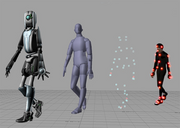
An example of Computer animation produced using Motion capture
Computer animation is the art of creating moving images via the use of computers. It is a subfield of computer graphics and animation. Increasingly it is created by means of 3D computer graphics, though 2D computer graphics are still widely used for stylistic, low bandwidth, and faster real-time rendering needs. Sometimes the target of the animation is the computer itself, but sometimes the target is another medium, such as film. It is also referred to as CGI (Computer-generated imagery or computer-generated imaging), especially when used in films.
Virtual entities may contain and be controlled by assorted attributes, such as transform values (location, orientation, scale; see Cartesian coordinate system) stored in an object's transformation matrix. Animation is the change of an attribute over time. Multiple methods of achieving animation exist; the rudimentary form is based on the creation and editing of keyframes, each storing a value at a given time, per attribute to be animated. The 2D/3D graphics software will interpolate between keyframes, creating an editable curve of a value mapped over time, resulting in animation. Other methods of animation include procedural and expression-based techniques: the former consolidates related elements of animated entities into sets of attributes, useful for creating particle effects and crowd simulations; the latter allows an evaluated result returned from a user-defined logical expression, coupled with mathematics, to automate animation in a predictable way (convenient for controlling bone behavior beyond what a hierarchy offers in skeletal system set up).
To create the illusion of movement, an image is displayed on the computer screen then quickly replaced by a new image that is similar to the previous image, but shifted slightly. This technique is identical to the illusion of movement in television and motion pictures.
[edit] Concepts and Principles
[edit] Image
An image or picture is an artifact that resembles a physical object or person. The term includes two-dimensional objects like photographs and sometimes includes three-dimensional representations. Images are captured by optical devices—such as cameras, mirrors, lenses, telescopes, microscopes, etc. and natural objects and phenomena, such as the human eye or water surfaces.
A digital image is a representation of a two-dimensional image in binary format as a sequence of ones and zeros. Digital images include both vector images and raster images, but raster images are more commonly used.
[edit] Pixel

In the enlarged portion of the image individual pixels are rendered as squares and can be easily seen.
In digital imaging, a pixel (or picture element[7]) is a single point in a raster image. Pixels are normally arranged in a regular 2-dimensional grid, and are often represented using dots or squares. Each pixel is a sample of an original image, where more samples typically provide a more accurate representation of the original. The intensity of each pixel is variable; in color systems, each pixel has typically three or four components such as red, green, and blue, or cyan, magenta, yellow, and black.
[edit] Graphics
Graphics are visual presentations on some surface, such as a wall, canvas, computer screen, paper, or stone to brand, inform, illustrate, or entertain. Examples are photographs, drawings, line art, graphs, diagrams, typography, numbers, symbols, geometric designs, maps, engineering drawings, or other images. Graphics often combine text, illustration, and color. Graphic design may consist of the deliberate selection, creation, or arrangement of typography alone, as in a brochure, flier, poster, web site, or book without any other element. Clarity or effective communication may be the objective, association with other cultural elements may be sought, or merely, the creation of a distinctive style.
[edit] Rendering
Rendering is the process of generating an image from a model, by means of computer programs. The model is a description of three dimensional objects in a strictly defined language or data structure. It would contain geometry, viewpoint, texture, lighting, and shading information. The image is a digital image or raster graphics image. The term may be by analogy with an "artist's rendering" of a scene. 'Rendering' is also used to describe the process of calculating effects in a video editing file to produce final video output.
- 3D projection
- 3D projection is a method of mapping three dimensional points to a two dimensional plane. As most current methods for displaying graphical data are based on planar two dimensional media, the use of this type of projection is widespread, especially in computer graphics, engineering and drafting.
- Ray tracing
- Ray tracing is a technique for generating an image by tracing the path of light through pixels in an image plane. The technique is capable of producing a very high degree of photorealism; usually higher than that of typical scanline rendering methods, but at a greater computational cost.
- Shading
- Shading refers to depicting depth in 3D models or illustrations by varying levels of darkness. It is a process used in drawing for depicting levels of darkness on paper by applying media more densely or with a darker shade for darker areas, and less densely or with a lighter shade for lighter areas. There are various techniques of shading including cross hatching where perpendicular lines of varying closeness are drawn in a grid pattern to shade an area. The closer the lines are together, the darker the area appears. Likewise, the farther apart the lines are, the lighter the area appears. The term has been recently generalized to mean that shaders are applied.
- Texture mapping
- Texture mapping is a method for adding detail, surface texture, or colour to a computer-generated graphic or 3D model. Its application to 3D graphics was pioneered by Dr Edwin Catmull in 1974. A texture map is applied (mapped) to the surface of a shape, or polygon. This process is akin to applying patterned paper to a plain white box. Multitexturing is the use of more than one texture at a time on a polygon.[8] Procedural textures (created from adjusting parameters of an underlying algorithm that produces an output texture), and bitmap textures (created in an image editing application) are, generally speaking, common methods of implementing texture definition from a 3D animation program, while intended placement of textures onto a model's surface often requires a technique known as UV mapping.
[edit] Volume rendering

Volume rendered
CT scan of a forearm with different colour schemes for muscle, fat, bone, and blood.
Volume rendering is a technique used to display a 2D projection of a 3D discretely sampled data set. A typical 3D data set is a group of 2D slice images acquired by a CT or MRI scanner.
Usually these are acquired in a regular pattern (e.g., one slice every millimeter) and usually have a regular number of image pixels in a regular pattern. This is an example of a regular volumetric grid, with each volume element, or voxel represented by a single value that is obtained by sampling the immediate area surrounding the voxel.
[edit] 3D modeling
3D modeling is the process of developing a mathematical, wireframe representation of any three-dimensional object, called a "3D model", via specialized software. Models may be created automatically or manually; the manual modeling process of preparing geometric data for 3D computer graphics is similar to plastic arts such as sculpting. 3D models may be created using multiple approaches: use of NURBS curves to generate accurate and smooth surface patches, polygonal mesh modeling (manipulation of faceted geometry), or polygonal mesh subdivision (advanced tessellation of polygons, resulting in smooth surfaces similar to NURBS models). A 3D model can be displayed as a two-dimensional image through a process called 3D rendering, used in a computer simulation of physical phenomena, or animated directly for other purposes. The model can also be physically created using 3D Printing devices.
[edit] Pioneers in graphic design
- Charles Csuri
- Charles Csuri is a pioneer in computer animation and digital fine art and created the first computer art in 1964. Csuri was recognized by Smithsonian as the father of digital art and computer animation, and as a pioneer of computer animation by the Museum of Modern Art (MoMA) and (ACM-SIGGRAPH).
- Donald P. Greenberg
- Donald P. Greenberg is a leading innovator in computer graphics. Greenberg has authored hundreds of articles and served as a teacher and mentor to many prominent computer graphic artists, animators, and researchers such as Robert L. Cook, Marc Levoy, and Wayne Lytle. Many of his former students have won Academy Awards for technical achievements and several have won the SIGGRAPH Achievement Award. Greenberg was the founding director of the NSF Center for Computer Graphics and Scientific Visualization.
- A. Michael Noll
- Noll was one of the first researchers to use a digital computer to create artistic patterns and to formalize the use of random processes in the creation of visual arts. He began creating digital computer art in 1962, making him one of the earliest digital computer artists. In 1965, Noll along with Frieder Nake and Georg Nees were the first to publicly exhibit their computer art. During April 1965, the Howard Wise Gallery exhibited Noll's computer art along with random-dot patterns by Bela Julesz.
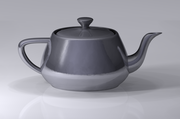
A modern render of the Utah teapot, an iconic model in 3D computer graphics created by Martin Newell, 1975.
- Other pioneers
- Benoît B. Mandelbrot
- Henri Gouraud
- Bui Tuong Phong
- Pierre Bézier
- Paul de Casteljau
- Daniel J. Sandin
- Alvy Ray Smith
- Ton Roosendaal
- Ivan Sutherland
- Steve Russell
[edit] The study of computer graphics
The study of computer graphics is a sub-field of computer science which studies methods for digitally synthesizing and manipulating visual content. Although the term often refers to three-dimensional computer graphics, it also encompasses two-dimensional graphics and image processing.
As an academic discipline, computer graphics studies the manipulation of visual and geometric information using computational techniques. It focuses on the mathematical and computational foundations of image generation and processing rather than purely aesthetic issues. Computer graphics is often differentiated from the field of visualization, although the two fields have many similarities.
[edit] Applications
 | Computer graphics portal |
 | Computer Science portal |
- Computational biology
- Computational physics
- Computer-aided design
- Computer simulation
- Digital art
- Education
- Graphic design
- Infographics
- Information visualization
- Rational drug design
- Scientific visualization
- Video Games
- Virtual reality
- Web design
![]() ...........................................
...........................................

 many students require more than one computer forensics certification. During the training class, you will be prepared to take:
many students require more than one computer forensics certification. During the training class, you will be prepared to take:



